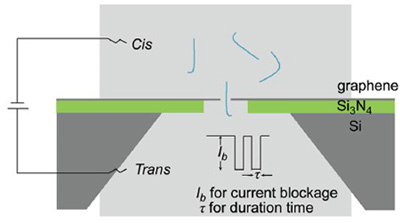| [1] Bayley, H. Curr. Opin. Chem. Biol. 2006, 10, 628.[2] Meyerson, M.; Gabriel, S.; Getz, G. Nat. Rev. Genet. 2010, 11, 685.[3] Hayden, E. C. Nature 2008, 451, 378.[4] Kayser, M.; de Knijff, P. Nat. Rev. Genet. 2011, 12, 179.[5] Zhou, X.; Ren, L.; Li, Y.; Zhang, M.; Yu, Y.; Yu, J. Sci. China, Life Sci. 2010, 53, 44.[6] Wanunu, M. Phys. Life Rev. 2012, 9, 125.[7] Church, G.; Deamer, D. W.; Branton, D.; Baldarelli, R.; Kasianowicz, J. US 5795782, 1998 [Chem. Abstr. 1996, 126, 4207].[8] Kasianowicz, J. J.; Brandin, E.; Branton, D.; Deamer, D. W. Proc. Natl. Acad. Sci. U. S. A. 1996, 93, 13770.[9] Schneider, G. F.; Dekker, C. Nat. Biotech. 2012, 30, 326.[10] Venkatesan, B. M.; Bashir, R. Nat. Nanotech. 2011, 6, 615.[11] Deamer, D. W.; Akeson, M. Trends Biotech. 2000, 18, 147.[12] Li, J.; Stein, D.; McMullan, C.; Branton, D.; Aziz, M. J.; Golovchenko, J. A. Nature 2001, 412, 166.[13] Storm, A. J.; Chen, J. H.; Ling, X. S.; Zandbergen, H. W.; Dekker, C. Nat. Mater. 2003, 2, 537.[14] Siwy, Z.; Fuliński, A. Phys. Rev. Lett. 2002, 89, 198103.[15] Langecker, M.; Arnaut, V.; Martin, T. G.; List, J.; Renner, S.; Mayer, M.; Dietz, H.; Simmel, F. C. Science 2012, 338, 932.[16] Liu, H.; He, J.; Tang, J.; Liu, H.; Pang, P.; Cao, D.; Krstic, P.; Joseph, S.; Lindsay, S.; Nuckolls, C. Science 2010, 327, 64.[17] Wang, Z.; Huang, S. CN ZL200610147236. 3, 2006[Chem. Abstr. 2007, 147, 230108].[18] Sha, J.; Hasan, T.; Milana, S.; Bertulli, C.; Bell, N. A. W.; Privitera, G.; Ni, Z.; Chen, Y.; Bonaccorso, F.; Ferrari, A. C.; Keyser, U. F.; Huang, Y. Y. S. ACS Nano 2013, 7, 8857.[19] Liu, S.; Lu, B.; Zhao, Q.; Li, J.; Gao, T.; Chen, Y.; Zhang, Y.; Liu, Z.; Fan, Z.; Yang, F.; You, L.; Yu, D. Adv. Mater. 2013, 25, 4549.[20] Meller, A.; Nivon, L.; Brandin, E.; Golovchenko, J.; Branton, D. Proc. Natl. Acad. Sci. U. S. A. 2000, 97, 1079.[21] Venta, K.; Shemer, G.; Puster, M.; Rodriguez-Manzo, J. A.; Balan, A.; Rosenstein, J. K.; Shepard, K.; Drndi?, M. ACS Nano 2013, 7, 4629.[22] Ying, Y.-L.; Zhang, J.; Gao, R.; Long, Y.-T. Angew. Chem., Int. Ed. 2013, 52, 13154.[23] Ying, Y.; Zhang, X.; Liu, Y.; Xue, M.; Li, H.; Long, Y. Acta Chim. Sinica 2013, 71, 44. (应佚伦, 张星, 刘钰, 薛梦竹, 李洪林, 龙亿涛, 化学学报, 2013, 71, 44.)[24] Venta, K.; Wanunu, M.; Drndi?, M. Nano Lett. 2013, 13, 423.[25] Liu, A.; Zhao, Q.; Guan, X. Anal. Chim. Acta 2010, 675, 106.[26] Garaj, S.; Hubbard, W.; Reina, A.; Kong, J.; Branton, D.; Golovchenko, J. Nature 2010, 467, 190.[27] Merchant, C. A.; Healy, K.; Wanunu, M.; Ray, V.; Peterman, N.; Bartel, J.; Fischbein, M. D.; Venta, K.; Luo, Z.; Johnson, A. T. C.; Drndi?, M. Nano Lett. 2010, 10, 2915.[28] Nelson, T.; Zhang, B.; Prezhdo, O. V. Nano Lett. 2010, 10, 3237.[29] Postma, H. W. Nano Lett. 2010, 10, 420.[30] Schneider, G. F.; Kowalczyk, S. W.; Calado, V. E.; Pandraud, G.; Zandbergen, H. W.; Vandersypen, L. M.; Dekker, C. Nano Lett. 2010, 10, 3163.[31] Kim, M. J.; McNally, B.; Murata, K.; Meller, A. Nanotechnology 2007, 18, 205302.[32] Liu, Q.; Wu, H.; Wu, L.; Xie, X.; Kong, J.; Ye, X.; Liu, L. Plos One 2012, 7, e46014.[33] Wanunu, M.; Sutin, J.; McNally, B.; Chow, A.; Meller, A. Biophys. J. 2008, 95, 4716.[34] Fologea, D.; Gershow, M.; Ledden, B.; McNabb, D. S.; Golovchenko, J. A.; Li, J. Nano Lett. 2005, 5, 1905.[35] Tabard-Cossa, V.; Trivedi, D.; Wiggin, M.; Jetha, N. N.; Marziali, A. Nanotechnology 2007, 18, 305505.[36] Clarke, J.; Wu, H.-C.; Jayasinghe, L.; Patel, A.; Reid, S.; Bayley, H. Nat. Nanotech. 2009, 4, 265.[37] Li, J.; Gershow, M.; Stein, D.; Brandin, E.; Golovchenko, J. A. Nat. Mater. 2003, 2, 611.[38] Smeets, R. M. M.; Keyser, U. F.; Dekker, N. H.; Dekker, C. Proc. Natl. Acad. Sci. U. S. A. 2008, 105, 417.[39] Hoogerheide, D. P.; Garaj, S.; Golovchenko, J. A. Phys. Rev. Lett. 2009, 102, 256804.[40] Bayley, H. Nature 2010, 467, 164. |
